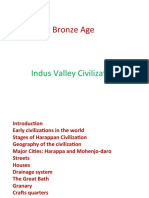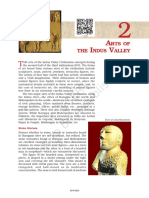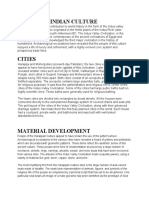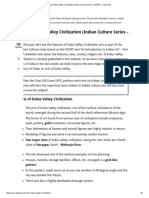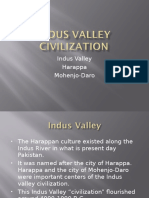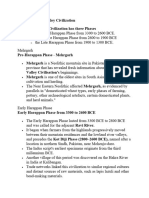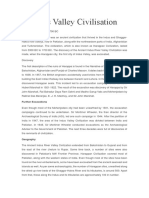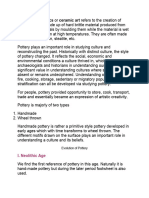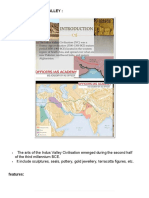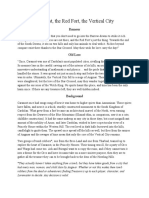Indus Valley Civilization
Indus Valley Civilization
Uploaded by
aaban riazCopyright:
Available Formats
Indus Valley Civilization
Indus Valley Civilization
Uploaded by
aaban riazCopyright
Available Formats
Share this document
Did you find this document useful?
Is this content inappropriate?
Copyright:
Available Formats
Indus Valley Civilization
Indus Valley Civilization
Uploaded by
aaban riazCopyright:
Available Formats
Indus Valley civilization
Indus civilization, also called Indus valley civilization or Harappan civilization, the
earliest known urban culture of the Indian subcontinent. The nuclear dates of the
civilization appear to be about 2500–1700 BCE, though the southern sites may
have lasted later into the 2nd millennium BCE.
Excavations of Indus cities have produced much evidence of artistic activity.
Such finds are important because they provide insights into the minds, lives,
and religious beliefs of their creators. Stone sculpture is extremely rare, and
much of it is quite crude. The total repertoire cannot compare to the work
done in Mesopotamia during the same periods. The figures are apparently all
intended as images for worship. Such figures include seated men, recumbent
composite animals, or—in unique instances (from Harappa)—a standing nude
male and a dancing figure. The finest pieces are of excellent quality. There is
also a small but notable repertoire of cast-bronze figures, including several
fragments and complete examples of dancing girls, small chariots, carts, and
animals. The technical excellence of the bronzes suggests a highly developed
art, but the number of examples is still small. They appear to be Indian
workmanship rather than imports.
The popular art of the Harappans was in the form of terra-cotta figurines. The
majority is of standing females, often heavily laden with jewelry, but standing
males—some with beard and horns—are also present. It has been generally
agreed that these figures are largely deities (perhaps a Great Mother and a
Great God), but some small figures of mothers with children or of domestic
activities are probably toys. There are varieties of terra-cotta animals, carts,
and toys—such as monkeys pierced to climb a string and cattle that nod their
heads. Painted pottery is the only evidence that there was a tradition of
painting. Much of the work is executed with boldness and delicacy of feeling,
but the restrictions of the art do not leave much scope for creativity.
The pottery of the Indus cities has all the marks of mass production. A substantial
proportion is thrown on the wheel (probably the same kind of foot wheel that is still
found in the Indus region and to the west to this day, as distinguished from the Indian
spun wheel common throughout the remaining parts of the subcontinent). The majority
of the pottery is competent plain ware, well-formed and fired but lacking
in aesthetic appeal. A substantial portion of the pottery has a red slip and is painted with
black decoration. Larger pots were probably built up on a turntable. Among the painted
designs, conventionalized vegetable patterns are common, and the elaborate geometric
designs of the painted pottery of Balochistan give way to simpler motifs, such as
intersecting circles or a scale pattern. Birds, animals, fish, and more interesting scenes
are comparatively rare. Of the vessel forms, a shallow platter on a tall stand (known as
the offering stand) is noteworthy, as is a tall cylindrical vessel perforated with small
holes over its entire length and often open at top and bottom. The function of this latter
vessel remains a mystery.
Although little has survived, very great interest attaches to the fragments of cotton
textiles recovered at Mohenjo-daro. These provide the earliest evidence of a crop and
industry for which India has long been famous. It is assumed that the raw cotton must
have been brought in bales to the cities to be spun, woven, and perhaps dyed, as the
presence of dyers’ vats would seem to indicate.
Stone, although largely absent from the great alluvial plain of the Indus, played a major
role in Harappan material culture. Scattered sources, mostly on the periphery, were
exploited as major factory sites. Thus, the stone blades found in great numbers at
Mohenjo-daro originated in the flint quarries at Sukkur, where they were probably
struck in quantity from prepared cores.
You might also like
- The Cambridge History of Iran Vol.2Document940 pagesThe Cambridge History of Iran Vol.2Adrian Florin Cotuţiu75% (8)
- Nubia and Nubians The 'Museumization' of A CultureDocument307 pagesNubia and Nubians The 'Museumization' of A CultureAmany SayedNo ratings yet
- Lesson - 2 Notes of Indus ValleyDocument2 pagesLesson - 2 Notes of Indus Valleyshalini agarwalNo ratings yet
- Bronze Age: Indus Valley CivilizationDocument39 pagesBronze Age: Indus Valley CivilizationRax MaxNo ratings yet
- INDUS VALLEY PPT by VaibhavDocument20 pagesINDUS VALLEY PPT by Vaibhavsandhaya1830No ratings yet
- Art of Indus ValleyDocument10 pagesArt of Indus ValleyThejasvi AtmadasaNo ratings yet
- History Assignment 1Document3 pagesHistory Assignment 1Anjali VyasNo ratings yet
- Indus Valley Power PointDocument20 pagesIndus Valley Power PointijustyadavNo ratings yet
- Life in HarrapaDocument9 pagesLife in Harrapasonam2411No ratings yet
- Indus Valley Civilization: History, Art & CultureDocument3 pagesIndus Valley Civilization: History, Art & Culturemirza dilawerNo ratings yet
- kefa102Document10 pageskefa102parthapratimgogoi35No ratings yet
- Grade 11 - Chapter 5 - Art of Indus ValleyDocument13 pagesGrade 11 - Chapter 5 - Art of Indus Valleymonicab100% (1)
- A Comprehensive Approach For UPSC Pre & Mains: UPSC Civil Services ExamDocument204 pagesA Comprehensive Approach For UPSC Pre & Mains: UPSC Civil Services ExamPrasant SahayNo ratings yet
- INDIAN CULTURE - Final PDFDocument204 pagesINDIAN CULTURE - Final PDFhelloitskalaiNo ratings yet
- INDIAN CULTURE - Final PDFDocument204 pagesINDIAN CULTURE - Final PDFSaurabh Mukherji100% (1)
- Harappa HistoryDocument4 pagesHarappa HistoryŚáńtőśh MőkáśhíNo ratings yet
- Chapter 2Document10 pagesChapter 2rockyravirockNo ratings yet
- Indus Valley CivilizationDocument7 pagesIndus Valley CivilizationShriNo ratings yet
- History of Indian CostumeDocument212 pagesHistory of Indian CostumeShashi Kant84% (32)
- History of Indian ArtDocument5 pagesHistory of Indian ArtSNo ratings yet
- RTS OF THE Ndus Alley: Stone StatuesDocument10 pagesRTS OF THE Ndus Alley: Stone StatuesDharma TejaNo ratings yet
- Indus Vally NotesDocument3 pagesIndus Vally NotesBapi SahaNo ratings yet
- Arts of Indus Valley Civilization (Indian Culture Series - NCERT)Document5 pagesArts of Indus Valley Civilization (Indian Culture Series - NCERT)yugiNo ratings yet
- Arts of Indus Valley Civilization (Indian Culture Series - NCERT)Document7 pagesArts of Indus Valley Civilization (Indian Culture Series - NCERT)RUSHALI SRIVASTAVANo ratings yet
- Cradle of Indian CultureDocument8 pagesCradle of Indian CultureicereiNo ratings yet
- Richa HistoeryDocument41 pagesRicha HistoeryAnubhav VermaNo ratings yet
- Indus Valley CivilizationDocument20 pagesIndus Valley CivilizationShubham KumarNo ratings yet
- XI Pinting Theory NotesDocument16 pagesXI Pinting Theory NotesMohit SinghNo ratings yet
- Ancient History of India: The Indus Valley CivilizationDocument18 pagesAncient History of India: The Indus Valley CivilizationAROKYASWAMY LNo ratings yet
- FINE ARTS HistoryDocument14 pagesFINE ARTS HistorypragnaseelaNo ratings yet
- Arts of Indus Valley Civilization IndianDocument8 pagesArts of Indus Valley Civilization IndianAnagh YadavNo ratings yet
- IAF Module 2 1,2,3finalDocument14 pagesIAF Module 2 1,2,3finalstudgg78No ratings yet
- Harappan Civilization: Subsistence PatternDocument8 pagesHarappan Civilization: Subsistence PatternShruti JainNo ratings yet
- 6987e621ba7d66c17e38ab0c98e932a9Document16 pages6987e621ba7d66c17e38ab0c98e932a9seosaad1816No ratings yet
- Unit 3Document12 pagesUnit 3CHUNCHUN KUMARNo ratings yet
- Indus Valley CivilizationDocument13 pagesIndus Valley CivilizationDevika SinghNo ratings yet
- Class 9 History Chapter - 1Document12 pagesClass 9 History Chapter - 1Rohan ParvathaNo ratings yet
- History of Ancient India UpdatedDocument31 pagesHistory of Ancient India Updatedaimansohail780No ratings yet
- Indus Valley Harappa Mohenjo-DaroDocument40 pagesIndus Valley Harappa Mohenjo-Daroanuj sethNo ratings yet
- Indian Art FormDocument7 pagesIndian Art FormRashi GambhirNo ratings yet
- Harappan Civilization or Indus Valley CivilizationDocument6 pagesHarappan Civilization or Indus Valley Civilizationkeshavnaikk789No ratings yet
- Harrappan CivilisationDocument6 pagesHarrappan CivilisationSakshi GourNo ratings yet
- Indus Valley CivilisationDocument4 pagesIndus Valley CivilisationRohan PandhareNo ratings yet
- History Assignment On Indus Valley CivilisationDocument10 pagesHistory Assignment On Indus Valley CivilisationkhushiisfunNo ratings yet
- Soumadri 1301Document46 pagesSoumadri 1301soumadri.2023.1301No ratings yet
- Indian ArtDocument5 pagesIndian ArtChandan KumarNo ratings yet
- Unit 5 - Itcs-1Document51 pagesUnit 5 - Itcs-1manyab009No ratings yet
- Harappan Civilization Brief NoteDocument9 pagesHarappan Civilization Brief Notearshitagupta2004No ratings yet
- Chapter 1 ANCIENT HISTORY OF INDIA 2Document3 pagesChapter 1 ANCIENT HISTORY OF INDIA 2Hum h banaras keNo ratings yet
- Introduction To Art NotesDocument24 pagesIntroduction To Art NotesNavjot SinghNo ratings yet
- History of South Asia 1Document11 pagesHistory of South Asia 1NOOB KINGNo ratings yet
- Introduction To Indian Culture (Fine Arts) - Class-XI PDFDocument61 pagesIntroduction To Indian Culture (Fine Arts) - Class-XI PDFPrakash Sundaram100% (1)
- Indus Valley NotesDocument9 pagesIndus Valley NotesNimisha SwarupNo ratings yet
- Ancient History Part 1Document7 pagesAncient History Part 1vishalbharati10230No ratings yet
- Art of Indus Valley Civilization XiDocument6 pagesArt of Indus Valley Civilization Xigargi4a16No ratings yet
- Static 1 - Ancient HistoryDocument39 pagesStatic 1 - Ancient History145 Raval RahulNo ratings yet
- Indus Civilization History NotesDocument9 pagesIndus Civilization History Notesmohammad azimNo ratings yet
- Indus Valley CivilisationDocument3 pagesIndus Valley CivilisationAmarinder BalNo ratings yet
- Indus Valley CivilizationDocument11 pagesIndus Valley CivilizationMeenakshi GoelNo ratings yet
- Features of Indus Valley CivilizationDocument9 pagesFeatures of Indus Valley CivilizationAwais KhanNo ratings yet
- Arts of The Indus ValleyDocument13 pagesArts of The Indus ValleyPrashant PatelNo ratings yet
- Interesting Facts About The Ancient African Art - Art History for Kids | Children's Art BooksFrom EverandInteresting Facts About The Ancient African Art - Art History for Kids | Children's Art BooksNo ratings yet
- Landmark - Caranost The Red Fort The Vertical CityDocument11 pagesLandmark - Caranost The Red Fort The Vertical CityhasLFaDNo ratings yet
- Listening SectionDocument31 pagesListening SectionSusanti JiahNo ratings yet
- The Mamasani archaeological project stage one a report on the first two seasons of the ICAR University of Sydney expedition to the Mamasani District Fars Province Iran University Of Sydney All Chapters Instant DownloadDocument45 pagesThe Mamasani archaeological project stage one a report on the first two seasons of the ICAR University of Sydney expedition to the Mamasani District Fars Province Iran University Of Sydney All Chapters Instant DownloadbehnasakanoNo ratings yet
- Copper Age and Bronze AgeDocument56 pagesCopper Age and Bronze AgeJack RobinsonNo ratings yet
- Underdstanding Culture Society and Politics ACAD TVL W - 4 6Document15 pagesUnderdstanding Culture Society and Politics ACAD TVL W - 4 6DM Camilot IINo ratings yet
- King TetiDocument24 pagesKing TetiAdhm sayedNo ratings yet
- Maritime Heritage Museum Synopsis 1Document3 pagesMaritime Heritage Museum Synopsis 1pranuNo ratings yet
- Boy in LuvDocument3 pagesBoy in LuvEster Mondido RagayNo ratings yet
- Martinon-Torres and Killick in Press Archaeological Theories and Archaeological SciencesDocument18 pagesMartinon-Torres and Killick in Press Archaeological Theories and Archaeological SciencesJenny BaloghNo ratings yet
- Lost Treasure 11Document25 pagesLost Treasure 11merlin7magikNo ratings yet
- Humanites LuxorDocument9 pagesHumanites Luxorleeza JavedNo ratings yet
- Gallery GuideDocument25 pagesGallery GuideWynn TohNo ratings yet
- Philosophy of Human Person and Other DisciplinesDocument1 pagePhilosophy of Human Person and Other DisciplinesSarahNo ratings yet
- Protection of Cultural Heritage Ss BiswasDocument4 pagesProtection of Cultural Heritage Ss BiswasJohn MiltonNo ratings yet
- Neolithic Farming Villages Jericho and Catal HuyukDocument1 pageNeolithic Farming Villages Jericho and Catal HuyukPream BoleoNo ratings yet
- Archive of Aurelius Heras, Praepositus PagiDocument1 pageArchive of Aurelius Heras, Praepositus Pagilmansour0218No ratings yet
- MY Day-1-EM AnsDocument10 pagesMY Day-1-EM AnsuttejNo ratings yet
- Middle Byzantine Period Weapons From TheDocument20 pagesMiddle Byzantine Period Weapons From TheVladan VidosavljevićNo ratings yet
- Ancient Egypt Escape The RoomDocument9 pagesAncient Egypt Escape The RoomInabat YessirkepNo ratings yet
- Grand Canyon Pyramid Decode 3Document28 pagesGrand Canyon Pyramid Decode 3Masoud KhodaNo ratings yet
- Punch-Marked CoinsDocument3 pagesPunch-Marked Coinstsiddharth520No ratings yet
- Bones Preservation and Conservation PDFDocument351 pagesBones Preservation and Conservation PDFElena CozmaNo ratings yet
- Late La Tene Ceramic From BulgariaDocument9 pagesLate La Tene Ceramic From Bulgariacharles9470.kissNo ratings yet
- Full How To of Qualitative Research 1St Edition Aurini Test Bank Online PDF All ChapterDocument26 pagesFull How To of Qualitative Research 1St Edition Aurini Test Bank Online PDF All Chapterpauleharyanvb493100% (8)
- Queen of The Sea A History of Lisbon by Barry HattonDocument342 pagesQueen of The Sea A History of Lisbon by Barry HattonCrypto TrackerNo ratings yet
- Fibulae From Apollonia Pontica (+)Document30 pagesFibulae From Apollonia Pontica (+)Umut DoğanNo ratings yet
- My Class Notes For Potery Class 2Document3 pagesMy Class Notes For Potery Class 2meNo ratings yet
- The Antediluvian Patriarchs and The Sumerian King List 4n4774ei70Document11 pagesThe Antediluvian Patriarchs and The Sumerian King List 4n4774ei70HarryNo ratings yet



